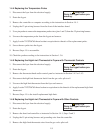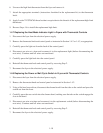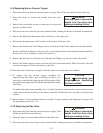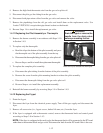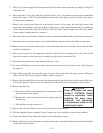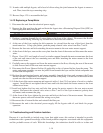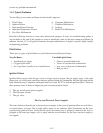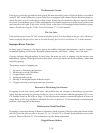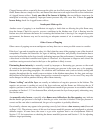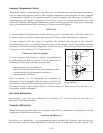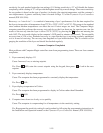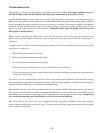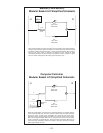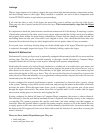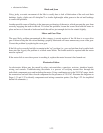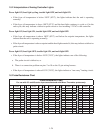1-17
Clogged burner orifi ces, especially those near the pilot, are also likely causes of delayed ignition. Lack of
fl ame, fl ames that are orange in color, and fl ames that shoot out at an angle from the rest are indications
of clogged burner orifi ces. If only one side of the burner is lighting, the rear defl ector target may be
misaligned or missing completely. Improper burner pressure may also cause this. If there are gaps in
burner fi ring, check for clogged burner orifi ces.
Inadequate Make-up Air
Another cause of popping is an insuffi cient air supply or drafts that are blowing the pilot fl ame away
from the burner. Check for negative pressure conditions in the kitchen area. If air is fl owing into the
kitchen area, this indicates that more air is entering the kitchen than is leaving it. In a negative pressure
environment, the burners may not be receiving an adequate amount of air to maintain a strong pilot
fl ame.
Other Causes of Popping
Other causes of popping are more ambiguous and may have two or more possible causes to consider.
If the fryer’s gas and air supplies are okay, it is likely that the cause of the popping is one of the electrical
components. Examine the controller for signs of melting, distortion, and possibly discoloration due to
excessive heat buildup in the fryer (usually indicating improper fl ue performance). Automatically suspect
a discolored or distorted controller and replace it. However, it is important to diagnose and correct the
condition causing excessive heat in the fryer or the problem is likely to recur.
Fluctuating fl ame intensity is normally caused by improper or fl uctuating gas pressure or the result
of variations in the kitchen atmosphere. Verify incoming gas pressure in the same way as for popping,
discussed in the preceding paragraphs. Air condition and ventilation units (such as hoods) starting and
stopping throughout the day usually cause variations in the kitchen atmosphere. As they start and stop,
the pressure in the kitchen may change from positive or neutral to negative, or vice versa. They may also
cause changes in airfl ow patterns that may affect fl ame intensity.
Flames “rolling” out of the fryer are usually an indication of negative pressure in the kitchen. The
negative air pressure is sucking air out of the fryer enclosure and the fl ames are following the air. If
negative pressure is not the cause, check for high burner manifold gas pressure in accordance with the
procedures in Section 1.3.2. An obstructed fl ue, which prevents the fryer from properly exhausting, may
also be the cause.
An unusually noisy burner, especially when fl ames are visible above the fl ue opening, may indicate
that the burner gas pressure is too high or that the gas valve vent tube is blocked. If the gas pressure is
correct and the vent tube is unobstructed, the gas valve regulator is probably defective.
Occasionally, a burner may appear to be operating correctly, but it shows a slow recovery rate (discussed
on Page 1-18). The primary causes of this are low burner manifold pressure and misaligned or missing
defl ector targets. In some cases, the cause is a gas valve regulator that is out of adjustment. Refer to
Section 1.3.2 for instructions on checking the burner manifold pressure and Section 1.3.4 for adjusting
defl ector target positioning.



